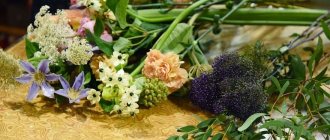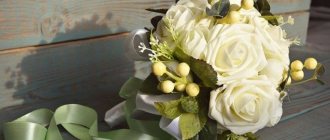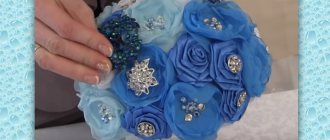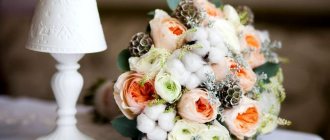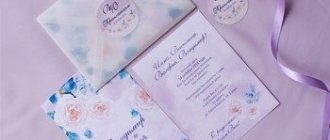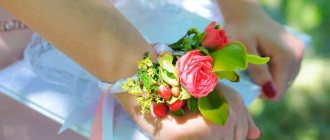Among the mandatory attributes of a wedding, the bride's bouquet has a special meaning and plays an important role. That’s why they approach its compilation with trepidation, tenderness, and great attention.
A flower arrangement can be made up of live or artificial plants, but besides this, it is also important what flowers it is made from. Having decided to make a wedding bouquet with your own hands, you first need to learn everything about what flowers go together, what such a combination means and how to achieve success in creating a composition.
Recommendations
The good thing about a natural bouquet is that you can make it yourself, saving significantly on the services of professional florists.
Some wedding styles, such as country or rustic, encourage the use of homegrown plants. Daffodils, tulips, peonies, gerberas, and roses bloom beautifully in the gardens of the middle zone. Thus, the bouquet will turn out to be both budget-friendly and sincere.
If you want to use imported flowers, be sure to consult with a florist you know to purchase a quality product. Place your order in advance, at least a month before the wedding. This way you will definitely get exactly the plants you dreamed of.

Take into account some negative nuances of a bouquet of fresh flowers:
- Fragility - not all petals will withstand numerous touches, frost, direct sunlight and drought, so carefully read the characteristics of the selected plants and, if necessary, place them in a vase immediately after the ceremonial procession and photographs.
- For a winter celebration, it is wise to choose from frost-resistant flowers , since there are quite a lot of them - carnations, tulips, ranunculus, chrysanthemums, and some types of roses.
- An important point is the smell and pollen. Some buds, for example, lilies, have a powerful aroma that will overpower your perfume and cause headaches or allergies. The same lilies are “famous” for their stamens, which can leave an orange mark on a dress.
Advice! To prevent lilies from staining your dress, remove the stamens or choose a bouquet shape that ensures pollen does not spill on the dress.
Decide what exactly you want from the composition - shape, shades, specific plants. Be sure to take into account both your own external data and the theme of the wedding. Classic celebrations love strict lines, thematic celebrations love asymmetry, cascade, and unusual execution. Tall brides should choose a larger bouquet, short brides should choose a miniature and neat one.
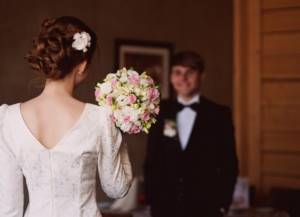
What should the bride's bouquet be like?
Taking into account age categories, the bride’s bouquet should be chosen as follows:
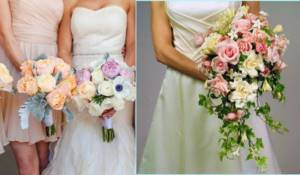
- For a mature bride, not only bright colors in a wedding bouquet are acceptable, but also an unusual design. A non-standard form of a bouquet, for example, or an exotic content of a bouquet.
- A bouquet made up of delicate shades and traditional flower specimens will suit the young bride. But this is not the only criterion.
Of course, you should take into account the wishes of the bride and her idea of what the main bouquet in her life should be. Another important point when composing a wedding bouquet is the theme of the wedding plot and the design of the decoration of the premises in which the main celebrations will take place.
It makes sense to consider the time of year in which the wedding is planned. After all, a winter wedding bouquet and a summer wedding bouquet can be played up taking into account the season and thus harmoniously fit it into the image of the newlywed.
It’s ideal when everything is thought out to the smallest detail, and even the bride’s bouquet is in harmony with the surrounding space.
Wedding bouquet shape
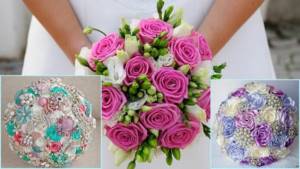
1) The round shape of the bride's bouquet is most often found at weddings. This is perhaps the best choice. The shape is pleasing to the eye and matches the mood and fits harmoniously into the format of the event.
A round wedding bouquet is traditionally made of roses. A wide variety of flowers in a variety of shades can be used. At the base of the bouquet, a special sponge soaked in moisture is used, which allows the flowers to maintain a fresh appearance throughout the entire special day.
2) It is customary to select flowers with a long stem for a cascade bouquet.
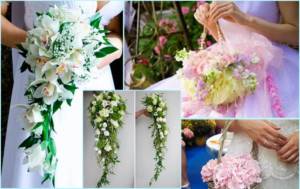
By intertwining them with each other, you can create a bouquet cascading down to a height of up to one meter. The bride should hold this bouquet with both hands, lowering them. A cascading bouquet also acts as a unique decoration for a wedding dress.
3) There is a type of “basket” bouquet, which is not as common now as before. It uses fresh flowers and in appearance it should create the impression of a basket of flowers. This form can be used in our time in the theme of a rural wedding. A basket bouquet filled with wildflowers and herbs will look very organic with the surrounding landscape.
4) A simple bouquet was often found at weddings in the last century, when our mothers and grandmothers got married. The flowers chosen for the bouquet were usually of the same variety and one or two shades. There could be any odd number of them in the bouquet, and they were tied with decorative ribbon. The bride wore such a bouquet along her arm, reclining.
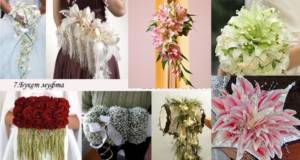
5) There is also a type of bouquet in the shape of a drop. Technically, it is a wire bent in the shape of a drop, braided with flowers. Larger flowers are used in the upper part of such a bouquet, and smaller ones in the lower part.
6) A bouquet in the shape of a muff is worn on the hand. This bouquet has a functional loop. It is needed to free your hand. At the right moment, the bride simply puts a loop on her finger and her palm becomes free, and the bouquet is clearly fixed and will not go anywhere.
Form
If you are determined to make an important accessory yourself, then soberly assess your capabilities.
Without any experience, you should not try to immediately repeat complex floral masterpieces, especially with expensive flowers. Start simple - with a classic circle. To create this shape, flowers are placed slightly at an angle, so that the buds create a circle and the stems create a single stem.
It is best to choose plants with straight but rather flexible stems for such compositions. However, in any case, you will have to secure the leg with floral wire. If desired, the leg can be replaced with a porta bouquet. On top we add decor carefully selected for the floral composition, outfit and style of the wedding - satin ribbon, a piece of chiffon fabric, lace.
A more complex option is a cascading composition in the form of a waterfall. For it you will need a little more time, an abundance of greenery and plants with the longest stem possible, or with a natural flowing shape, for example, orchids.
An interesting and simple to make pomander is a bouquet in the shape of a sphere, attached not to a stem, but to a ribbon. For it you will need a round floral sponge, into which you will place the buds.
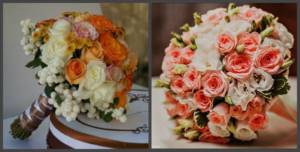
Color selection
The modern floristic market offers a variety of options: from field plants of our strip to exotic protea, turmeric, and orchids. You should choose based on your taste, the theme of the wedding and the characteristics of the flowers - the more hardy they are, the less you have to worry about preserving their freshness.
The classic version is roses, a symbol of love and romance. Red, pink, white, strict elongated or fluffy peony-shaped, large or miniature - regal flowers look excellent in any case. Keep in mind that, firstly, the thorns must be cut off from roses, and secondly, they are not very fond of their neighbors in the vase, so after the celebration the bouquet will have to be divided.
Another common option is exquisite lilies or sensual orchids , which confidently hold the second position in the top flowers for a wedding bouquet.
Idea! A cute and unusual choice is garden and wildflowers. Tulips, daffodils, chrysanthemums, freesias, and peonies look no worse than the royal trio and allow you to create truly interesting combinations.
Exotic alstroemeria, eustoma, anemones, callas are also quite often used in bouquets of various shapes. If you choose additional greenery to create volume, then pay attention to fern, eucalyptus, and gypsophila.
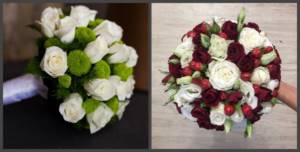
How to choose by style
When choosing the components of the composition, it is very important to take into account the style of the wedding, what colors are used in the decoration, the seasonality of the flowers and their resistance to weather conditions.
- For weddings in a rustic, country, or hippie style, it is better to turn your attention to wildflowers, which are successfully cultivated in greenhouses along with garden ones.
- For a magnificent celebration, bouquets are made to match - expensive, richly decorated, with exotic flowers.
- For unusual, themed weddings, unusual accessories are also compiled - you can find everything in them: from lotus flowers to succulents, cotton bolls and feathers.
- For a classic wedding - smooth, sleek compositions with classic flowers.
Plant preparation
In order for the buds to delight you during the long wedding day, you should take care of them in advance. Frost-resistant plants - tulips, roses, carnations - are recommended to be put in the refrigerator in the vegetable compartment the day before the wedding.
More delicate flowers that cannot tolerate cold should not be subjected to the cold test. Choose a dark, cool, draft-free place for them. They will be preserved best there.
Pour clean water into the vase, preferably rain or filtered water at room temperature. A good help would be either specialized fertilizers for cut flowers, or granulated sugar or aspirin dissolved in water.
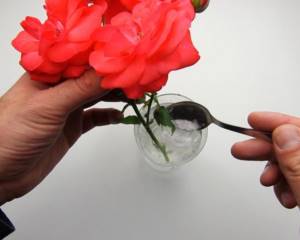
Important! Do not forget to tear off the leaves that will be under water after immersion. If this is not done, then rotten greenery will spoil the water and accelerate the withering of the buds.
Here are some more useful tips from florists:
- Roses, hydrangeas and chrysanthemums have their stems slightly split in front of the vase. This way they absorb moisture better;
- It is recommended to alternately dip the tip of the stem into boiling water and cold water several times for peonies or dahlias - this will help to revive them;
- Never spray water on the delicate petals of lilies, tuberose or daffodils. Unsightly stains may remain.
This video clearly shows how to trim flowers correctly:
Kinds
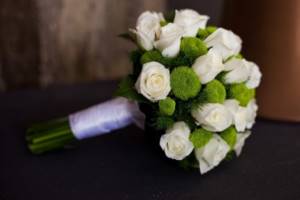
Before you think about how to assemble a bride’s bouquet with your own hands, you need to decide on the type of composition. Various options are possible.
- On the stems . The classic version, with a spiral assembly. The flowers are collected and tied with ribbon.
- On a portaquet. This accessory lasts well throughout the wedding day, since the base of the porta bouquet holder consists of a sponge, which is pre-soaked in water.
- On a wire. Each flower is attached separately to a wire, on the top of which there is a separate reservoir with liquid, and then assembled into a common composition.
Wedding decorations
A lot depends on the specific bouquet and wedding theme.
A rustic, rustic or eco-celebration does not require decoration; it is enough to grab the stems with ordinary twine. Vintage, shabby chic, retro, on the contrary, require the use of rhinestones, feathers, lace, and decorative pendants.
The easiest way to decorate is with greenery. Originally shaped leaves will add freshness and life to the composition.
The design of the legs will allow you to place the necessary accents. It can be wrapped in fabric, ribbons, lace, beads, appliqués.
Seasonal decor is also interesting. So, in winter, pine cones or spruce branches look great in a bouquet, in spring - pussy willows, in summer - ears of corn and dried flowers, and in autumn - berries and fruits.
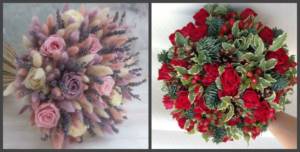
DIY compilation
Tools and materials
Before you start, prepare everything you need:
- The most important thing you will need is a well-sharpened pruning shears, because trimming the stems is necessary for any composition;
- A porta bouquet will make life easier. The floral sponge in it, of course, adds weight to the accessory, but at the same time retains moisture, which means even the most capricious peonies will not wither;
- You can’t do without durable floral wire. It will hold the leg or lid of the bouquet holder and allow you to give the composition the required shape;
- Decorative elements are no less important - paper, ribbon, fabric, and other decorative elements. You will have to secure them in a variety of ways, so have a stapler, glue and pins ready.
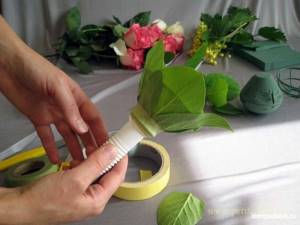
To work you will need:
- 9 large roses of the desired shade;
- 5 branches of spray roses a shade lighter;
- 3 sprigs of white gypsophila;
- floral wire;
- satin ribbon to match the buds;
- pruning shears or sharpened knife;
- scissors;
- transparent rhinestones;
- glue.
Step-by-step instructions with video
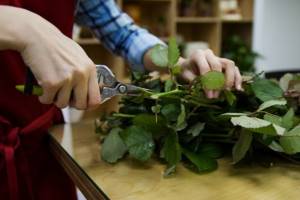
- First, let's prepare the roses - cut off the thorns and all the leaves. Keep in mind that the working surface is 5 cm from the beginning of the bud, then the stem begins;
- We lay out the flowers in a spiral , so that the buds form a circle. Large roses - in the center, then bush roses, and gypsophila along the edges;
- When everything is ready, we tightly tie the stems with floral wire , preferably in several circles in a spiral. We cut off all stems that fall below the specified length with pruning shears;
Advice! The leg is usually made 20 cm long, but if desired, you can vary it up or down. The main thing is that the resulting accessory fits comfortably in the palm of your hand.
- Cover the wire with satin ribbon. You can wrap the leg either entirely or only over the wire frame;
- Glue the rhinestones onto the tape in the right places.
A rather simple, but incredibly charming bouquet of fresh flowers is ready!
Another option on how to assemble an original bouquet is in this video:
Useful video: master class on creating a cascade composition
Cascade compositions are very popular among modern brides. It will not require serious skills or unusual materials. How to create a bridal bouquet with your own hands step by step can be seen in the video below:
A DIY wedding bouquet is created from the following materials:
- oasis (portable bouquet);
- white roses, freesias and eustomas;
- greens: ruscus and bergrass;
- soft transparent wire;
- pruner;
- satin ribbon;
- pearl beads;
- transparent glue.
A DIY wedding bouquet is assembled step by step as described below.
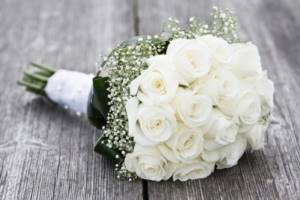
- First, let’s install the portaquet holder in a position convenient for work. A tall vase that holds the oasis in a vertical position is suitable for this.
- We take three roses with the smallest flowers or buds. We cut the leg at an angle so that it is convenient to insert it into the oasis. We wrap the edge of the leg tightly with wire. These three roses will be the basis of the entire cascade.
- We insert the roses into the oasis from bottom to top, at an acute angle. We fix the wire inserted along with the legs on the other side of the portaquet. This is necessary so that the flowers do not fall out under their own weight. Roses arranged in a cascade should be arranged asymmetrically.
- We also insert the remaining few roses asymmetrically throughout the oasis ball. To do this, you need to cut off the entire stem, leaving a stem 6-7 cm long.
- The free space between the roses is filled with freesia flowers. A flower can be inserted into a portaquet holder 1 time. If you placed it poorly, you will have to make a new hole. The oasis material is fragile.
- To the cascade of roses we add long (along the length of the cascade) branches of ruscus. Since the greens are lightweight, there is no need to secure them with wire. We just stick the branches in like roses – from the bottom up. We insert several separate short branches of ruscus throughout the composition, among roses and freesias.
- We also insert eustoma inflorescences, from bottom to top, into the cascade, filling the space between the roses.
- We string beads onto a wire, scatter them in separate drops and fix them throughout the composition.
- The edge of the porta bouquet's leg is covered with ruscus leaves, the rest of the space is decorated with a satin ribbon. Now you know exactly how to make a bridal bouquet with your own hands.
Important! Flowers in the oasis are not secured by anything - therefore, it is better to hold a simple bridal bouquet created with your own hands vertically or place it in a vase. Read more about bouquets on bouquet holders in this article.
Photo
Classics never go out of fashion, therefore, despite the widespread popularity of original wedding compositions, a bride’s bouquet made from fresh flowers never ceases to be popular. Regardless of the elements used, it emphasizes the natural beauty of the girl, her delicate taste, femininity and youth of soul, as in these photos:

The role of the accessory
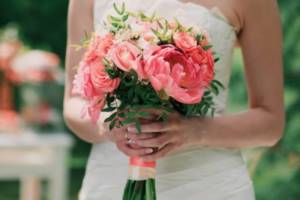
A bouquet is an essential accessory for any bride. It complements the image, makes it more gentle and chaste.
Attention! A bouquet is collected from a wide variety of flowers and plants; it can be live or artificial, of any color, size and content, and in some compositions flowers are not used at all.
Some girls prefer to order a bouquet from wedding florists (read here how to choose a real professional). Some people collect it in advance and from artificial materials. But there are also craftsmen who create a wedding bouquet with their own hands.

